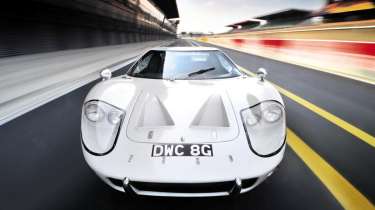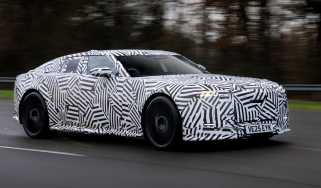Ford GT40 to Le Mans: evo10 Dream Drives
John Simister fulfils a childhood dream by driving a GT40 to Le Mans – and then being let loose on the legendary circuit
This is a dream involving a demister grille. Look at the base of a Ford GT40’s windscreen and you’ll see it, trapezoidal in outline, fine-grilled in the centre, coarse-louvred at the edges with vanes curved to direct air laterally.
My father’s Ford Zephyr MkIII had this grille, crackle-finished in blue. The Lotus Elan S3 I’ve just bought also has it, in black. And so does a GT40. I was a pre-teen child in the mid-1960s, I was a total Ford fan (Henry’s cars were so cool after the dreary, dated BMC products and desperate Vauxhall Victor we’d had to date), and when Ford decided to go endurance racing – with a car designed to win Le Mans! – I was in nirvana. We really had a little piece of the most beautiful, most fantastic racing car ever created, in our garage.
I devoured reports of every race involving GT40s, lapping up Motor magazine’s hour-by-hour Le Mans analyses of how the American-backed underdog first faltered, then dominated. Failure in 1964, the first year. Brute force with the seven-litre MkII in 1965, then failure again. Domination in 1966, an attempt to dead-heat with three MkIIs, victory actually going to the Bruce McLaren/Chris Amon car because, having started further down the grid order, it had travelled furthest in the 24 hours.
Next year, MkIIs still strong with Ronnie Bucknum initially leading, then victory to the honeycomb-construction MkIV of Dan Gurney and AJ Foyt which wasn’t really a GT40 at all. Seven-litre monster prototypes banned for 1968, but Gulf-backed, John Wyer-entered GT40s fighting back – and winning – in five-litre form, Pedro Rodriguez and Lucien Bianchi driving the victorious Ford. The same car, chassis 1075 shared this time by Jacky Ickx and Jackie Oliver, won again in 1969 as Ickx raced a Porsche 908 right up to the wire.
That’s a love affair continuously stoked over five years of a pre-pubescent Simister’s life. I built the IMC 1/25-scale kit (not 1/24, oddly) of the black 1966 winner with its silver stripes. I built 1/32 slot racers by Cox and Monogram. I still have them all.
Over four decades later, that feeling remains intact. A GT40 still brings out in me a flush of awe and adoration. So for me the dream, the ultimate drive, is obvious. Could I, finally, drive a GT40 at Le Mans? A real one, with provenance? And…maybe…drive it to Le Mans as well? It’s supposed to be a road-legal car, after all. Just.
So, here’s the plan. Ford UK owns two proper GT40s. Chassis 1008 is to race spec but has never raced. It was the 1960s demonstrator, used for publicity and by potential customers. It was even on the press fleet.
Originally green, it has at various times been repainted and partially rebodied to look like the 1968/69 Gulf cars or, with broadened rear bodywork, the 1966 LM-winning MkII. I nearly drove it in 1992, and was following it around Ford’s old Boreham test track in an Escort Cosworth when a chunk of metal flew out of its engine bay followed by a lot of coolant.
The crankshaft pulley had shattered, taking a corner of a cylinder head with it, so no drive for me that day. But I did get to try Ford’s other GT40, the final car in a seven-car run of MkIIIs and, as chassis number 1107, the final original GT40 to be built. These MkIIIs were created as proper roadgoing GT cars (up to a point); they have a longer tail with a rudimentary boot box thoughtfully placed above the lower-mounted exhaust system, the Borrani aluminium-rimmed wire wheels of the original 1964 cars, four round headlights and a modicum of interior civility. They also have a centrally-mounted gear lever, which both avoids finding the lever up your trouser leg as you contort yourself into the driving seat and makes a LHD version viable.
At Boreham, DWC 8G was not quite the car I’d hoped it would be. Then painted silver, it oozed history, having been the personal transport of Walter Hayes, the Ford PR supremo who was a prime mover in the GT40 project. But its age-hardened tyres were comically gripless, the gear lever’s tortuous, worn linkage made for a dire shift and the pace seemed far from that expected from 5 litres and a claimed 306bhp. Shattered dream? Well, it did take a bashing.
Over a decade later, both GT40s were restored. I met them again as Goodwood Revival course cars, 1008 now in Gulf colours and finally road-registered, 1107 now white. I drove DWC 8G for a course-car lap and found it transformed. Then, in 2006, 1008 was re-cast as an outward replica of the 1966 Le Mans-winning MkII to mark the win’s 40th anniversary. While the real thing was revisiting Le Mans for the LM Classic, I drove the replica up the hill at the Goodwood Festival of Speed that same weekend. I was briefly Bruce McLaren – just me, the GT40, a torrent of memories and fantasies as I found myself in that age-patinated cockpit.
And so to 2008 and evo’s 10th birthday. The black race car will be the one to take to Le Mans, despite the massive heat-soak into its cockpit which is said to make it intolerable after half an hour. Well, I’ll just have to tolerate it. It duly arrives at my house on its way to this year’s Goodwood Revival with DWC 8G, so I can photograph the start of a dream which will finish with the sight and sound of a black ‘MkII’ back at Le Mans, exhaust spitting that curiously high-pitched, hard-edged GT40 note so unexpected from a V8 with 90deg crankshaft throws.
This is unreal. Can it really be about to happen? No, as it happens. The race car blows a head gasket at Goodwood, a piece of gasket edge is ingested and it’s out of action. We’ll have to use DWC 8G instead.But think about it. The race car lacks external mirrors, cooks its driver, and its handbrake doesn’t work. It’s a highly-strung machine despite, nowadays, a fairly mild camshaft. The MkIII is properly road-driveable, and that means I can drive it all the way from Calais, where we unload it from its transport truck, to Le Mans.
It fires up instantly, helped by its electronic ignition conversion, after a few pedal-prods to prime the four-choke Holley carburettor. The roadgoing exhaust system is slightly silenced and there’s a link-pipe between the manifolds, so the note is regular V8 with a fidgety edge. As the GT40 eases out of the truck I’m struck by how retro this final example looks, how like the first cars – also white apart from a dark blue bonnet – which bridged an era between curvaceous trad and brutal modernity.
The wheelarches curve voluptuously over those 15in wire wheels, contrasting with the stocky, planted look of later racers with their wide-tyred magnesium wheels filling rounder, snugger openings. The long tail weakens the visual tension, the nose has much of the definitive GT40 look but is more bulbous above the wheels thanks to the large, curved headlamp covers. And instead of tiny vent flaps in the side windows, there are full-sized hinged panes.
Getting into a GT40 is not easy. You have to aim your legs either side of the steering wheel as you slide across the broad, high, carpeted sill; it helps if your left knee can bend sideways but mine, like most, cannot. The door is cut far into the roof to allow head-space as you slither inside, and once installed you’re almost lying on your back. But there’s a clear view forward, framed by those curving front wings, and the steering wheel – whose Ford GT legend is correct, unlike that of the side stripes – is closer than you’d expect.
There’s a fine array of dials, with the speedometer on the far left angled towards the driver and a fuel gauge able to show the contents of each sill-mounted tank. The eyeball air-vents are early MkIV Zephyr, cleverly reversible to allow either diffused or concentrated airflow. I’ll be needing these.
And now I’m on the road out of Calais, on my own in an irreplaceable piece of history. I really am driving to Le Mans in a real GT40 and it feels fantastic. The ZF gearbox is proving co-operative, with effective synchromesh even for the dogleg first gear, and the twin-plate clutch is properly progressive. The view over the shoulder isn’t nearly as restricted as you might think, and apart from a loud whine from the differential under power it’s quite civilised in here. The front suspension can’t cope with sharp ridges but otherwise the GT40 even rides well.
Civilised? Let’s explore the far reaches of the accelerator’s travel. There’s a bellow behind my head that gets left behind as the Ford squats its tail and leaps forward. At 4500rpm the tachometer goes into spasm but the power keeps coming until the fear of hidden gendarmes intervenes. The 306bhp is pretty much intact, I’d say.
It has a big heart but the GT40 is a small car, which helps make it a terrific overtaker with a sound barrage to stun all opposition. On autoroutes, N-roads and sinuous link roads it’s a joy, and less thirsty than the fuel gauge’s pessimistic plummeting suggests. I arrive at our overnight stop at Argentan high as a kite, and it’s not just the fumes of a rich mixture.
Next morning we have to leave very early. It’s still dark and there’s a lot of fog. An irreplaceable GT40, being driven in the fog. Just concentrate, OK? Then fog gives way to rush-hour traffic through the centre of Le Mans, the inhabitants barely believing what they are seeing as this white vision of the past lurks low among the buses, its driver staring up at their tailpipes.
We’re at the Le Mans track. I have half an hour on the Bugatti circuit, the permanent track which includes the pit straight and turns right into a twisting back section just after the Dunlop bridge and before Tertre Rouge. Half an hour, just the GT40 and me, to do as I like.
Is this real? Am I really pounding along the pit straight, flat in fifth, grandstands to the left, that semi-tyre bridge on the horizon? Have I just taken the rightward sweep without lifting, before braking hard and down to third gear for the chicane? I have, I am, and this is my dream realised after all these years.
Under the bridge and over the crest, but instead of going full bore on the way to the Mulsanne straight, where GT40s regularly broke the 200mph barrier, I have to turn hard right. Down to second as I enter the expanse of tarmac which marks the beginning of the Bugatti circuit, then third-fourth-third into a long left. Back up to fourth, down via third into second for a near-hairpin right. Now a good straight, if not quite the Mulsanne, then a left-right sweep and some esses before the tight, second-gear entry to the pit straight just down from, appropriately, the Ford Chicane. And I can do it all again, and again, until the Le Mans clock says neuf heures et demi.
And the GT40? Is it good on the track? Of course it is. It’s wearing very sticky Avon radials and getting the tail to power outwards is surprisingly hard. Instead the GT40 just digs in and powers through the fast bends, its steering ultra-quick, full of writhing feedback over ripples, never nervous. The nose is pushed wide in the tight corners, but a brief lift and a firm bung of the ample torque puts that right.
Next, we must tour the road part of the 24-hour circuit, mixing with the traffic against the backdrop of barriers. The Mulsanne straight has a roundabout in its road role, as does Mulsanne corner, but the Indianapolis section is exactly as it is for the race, complete with gently banked turns. It has barely changed since the 1960s.
Back at the circuit entrance, I place three Scalextric models of the top three 1966 Le Mans GT40s on the tarmacadam just in front of the real thing. For just a few minutes the man becomes a boy again. But this time, the boy’s dream has been made real. Thanks to Vincent Beaumesnil at Le Mans and to Ford for its fabulous GT40, ably looked after by Colin Gray.
evo10 moments
Two years ago we gathered a group of front-wheel-drive machinery to discover which was the best drivers’ car. I was in a tricky position because I was both a contributor of opinion and the owner of one of the cars to make the final top-six cut: the Peugeot 205 GTI 1.9.
We were deep in Welsh group-test territory: fast mountain roads, treacherous bends, heart-in-mouth crests. I was in a Mini GP, maddest of the first-generation BMW Minis and potentially the quickest car of the six. Ahead of me was R Meaden in my 205, the slowest car of the six, being driven with more pace and panache than it had ever been driven with before.
Could I keep up? No. Lacking Dickie’s supernatural ability, I wasn’t brave enough despite the power advantage. I watched as my 205 danced on the limit and disappeared into the distance, and hoped it would hold together through the next max-g bend. I felt a flush of pride: for my car in the face of newer opposition, and for Richard because back in 1993, both of us in previous lives, I gave him his first job in motoring journalism. John Simister
Specifications
| Engine | V8 |
| Location | Mid, longitudinal |
| Displacement | 4949cc |
| Bore x stroke | n/a |
| Cylinder block | Aluminium, dry sump |
| Cylinder head | Aluminium alloy, ohv, two valves per cylinder |
| Fuel and ignition | Electronic ignition, four-choke Holley carburettor |
| Max power | 306bhp @ 6000rpm |
| Max torque | 329lb ft @ 4200rpm |
| Transmission | Five-speed manual gearbox, rear-wheel drive |
| Front suspension | Double wishbones, coil springs, telescopic dampers, ARB |
| Rear suspension | Trailing arms, lower wishbones, coil springs, telescopic dampers, ARB |
| Brakes | Girling discs, 292mm front, 284mm rear |
| Wheels | 6.5 x 15in front, 8 x 15in rear, wire spoked |
| Tyres | 215/70 x 15 front, 245/60 x 15 rear, Avon radials |
| Steering | Rack and pinion, unassisted |
| Weight (kerb) | 998kg |
| Power-to-weight | 312bhp/ton |
| 0-60mph | 5.3sec |
| 0-100mph | 11.8sec |
| Top speed | 165mph |
| Basic price | £7549 in 1969 (c£400,000 today) |
| On sale | Afraid not |
| evo rating | 5/5 |




